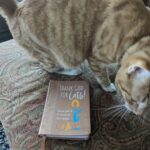Most novels feature the viewpoint character telling the story using the past tense. Yet more and more, readers are embracing present tense fiction. Novel writers need to understand tenses and how to best utilize them in their work.
Writing Tip for Today: What are the pros and cons of each tense?
Past Tense
Using a straight past tense (eg, she walked; he talked) gives readers a sense of familiarity and allows them to participate in the story from a slight distance. A first novel is often better rendered with past tense while the author is learning the craft, but go ahead and experiment, especially as you write your first draft. Try writing a scene or chapter first in past tense and then again in present tense. Decide which tense sounds best for the story as well as the character. Using past tense can make writing flash backs or back story a bit easier, as you would begin your back story with the first and last sentences in past perfect tense–in other words, using “had” in front of the past tense verb (He had walked). This helps readers understand “when” they are in time. Anything which sorts out confusion is a plus for the reader.
Present Tense
The present tense voice used to be maligned by authors and English teachers alike. (He talks, she walks. RIGHT NOW.) Not any more–many novels employ present tense for its ability to bring an urgency or immediacy to the story. Present tense makes readers experience the story in an “up close and personal” way that past tense cannot reproduce as easily. The downside to present tense is that in a novel-length work, it can be exhausting to be so intimate and immediate. Be sure your character is strong and well-developed enough to sustain a present tense narration. Again, try it both ways and decide which works best for the story you are writing. Present tense is also trickier in writing back story or flash backs: instead of “past perfect “had walked” you would use simple past tense. (He walks. Yesterday, he ran.) It’s correct but may throw readers unless you make it very clear that they’re reading about something that happened before the story’s NOW.
Weaving Back and Forth?
In my first novel, The Fence My Father Built, I switched between present and past tenses to delineate two different POV characters. This is acceptable, but do make sure you are clearly letting readers know who’s narrating and when they’re narrating it. Switching tenses in the same sentence, paragraph or scene is generally confusing, and tells readers you may not have full command of your English language skills. Master these tenses before you try to include past and present tenses in the same story.






I’very noticed this trend in such series as the Hunger Games
Tracy,
The Hunger Games is an excellent example of present tense in the novel. Note that Suzanne Collins’ writing is VERY strong–perhaps one reason that present tense works for these books.
Keep Writing!
Linda
Linda, some of the members of our Facebook group have English as a second language, and I’ve noticed they occasionally get tripped up with tenses. All writers have to deal with this choice though, even in writing poetry, so I sometimes encourage poets and writers to try each, read aloud, and see/hear which effect they prefer. Thanks for clarifying these choices well. I’ll highlight your post on the Christian Poets & Writers blog – http://christianpoetsandwriters.blogspot.com. God bless.
Thanks, Mary. I speak a little Spanish and the tense changes aren’t easy for me to remember, so I understand. Keep Writing,
Linda